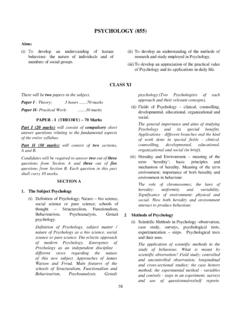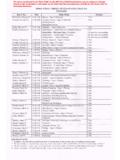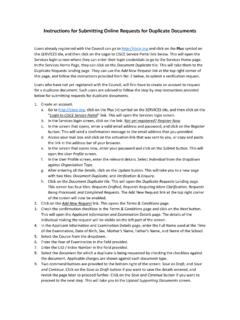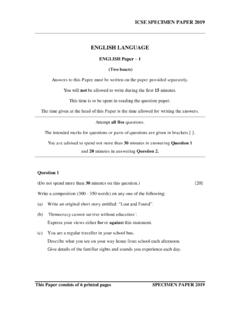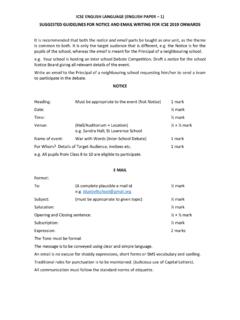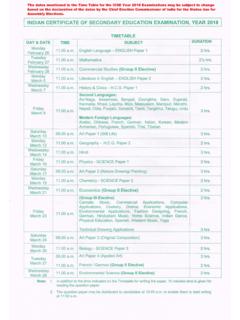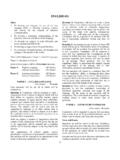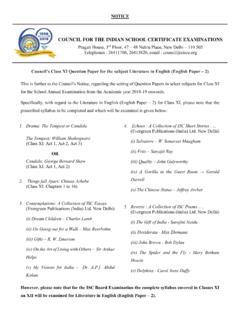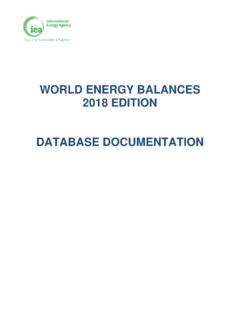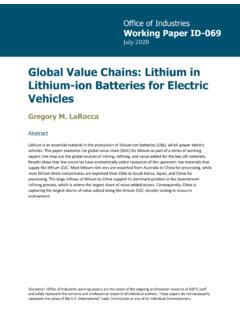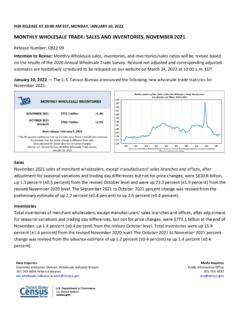Transcription of SCIENCE (52)
1 1 SCIENCE (52) CHEMISTRY SCIENCE Paper - 2 CLASS XThere will be one paper of two hours duration of 80 marks and Internal Assessment of practical work carrying 20 marks. The paper will be divided into two sections, Section I (40 marks) and Section II (40 marks). Section I (compulsory) will contain short answer questions on the entire syllabus. Section II will contain six questions. Candidates will be required to answer any four of these six questions.
2 Note: All chemical process/reactions should be studied with reference to the reactants, products, conditions, observation, the (balanced) equations and diagrams. 1. Periodic Properties and variations of Properties (i) Periodic properties and their variations in groups and periods. Definitions and trends of the following periodic properties in groups and periods should be studied: atomic size metallic character non-metallic character ionisation potential electron affinity electronegativity (ii) Periodicity on the basis of atomic number for elements.
3 The study of modern periodic table up to period 4 and Group 2 [IIA] (students to be exposed to the complete modern periodic table but no questions will be asked on elements beyond period 4 Calcium) Periodicity and other related properties to be explained on the basis of nuclear charge and shells (not orbitals). (Special reference to the alkali metals, alkaline earth metals, halogen groups and inert gases). 2. Chemical Bonding Electrovalent, covalent and co-ordinate bonding, structures of various compounds, Electron dot structure.
4 (a) Electrovalent bonding: Electron dot structure of Electrovalent compounds NaCl, MgCl2, CaO. Characteristic properties of electrovalent compounds state of existence, melting and boiling points, conductivity (heat and electricity), dissociation in solution and in molten state to be linked with electrolysis. (b) Covalent Bonding: Electron dot structure of non-polar covalent molecules on the basis of duplet and octet of electrons (example: hydrogen, chlorine, oxygen, nitrogen, carbon tetrachloride and methane.)
5 Polar Covalent compounds based on difference in electronegativity: Examples HCl, NH3 and H2O including electron dot structures. Characteristic properties of Covalent compounds state of existence, melting and boiling points, conductivity (heat and electricity), ionisation in solution. Comparison of Electrovalent and Covalent compounds. (c) Coordinate Bonding: Definition The lone pair effect of the oxygen atom of the water molecule and the nitrogen atom of the ammonia molecule to explain the formation of H3O+ and OH- ions in water and NH4+ ion.
6 The meaning of lone pair; the formation of hydronium ion and ammonium ion must be explained with help of electron dot diagrams. 3. Study of Acids, Bases and Salts (i) Simple definitions in terms of the molecules, their classification and characteristic properties. 2 (ii) Ions present in mineral acids, alkalis and salts and their solutions; use of common acid - base indicators and universal indicator , pH paper to test for acidity and alkalinity.
7 Examples with equation for the ionisation/dissociation of ions of acids, bases and salts. Acids form hydronium ions (only positive ions) and alkalis form hydroxyl ions (only negative ions) with water and their effect on indicators. Definitions - Salts are formed by partial or complete replacement of the hydrogen ion of an acid by a metal or Ionic definition of salt (To be explained with suitable examples). Introduction to pH scale to test for acidity, neutrality and alkalinity by using pH paper or Universal indicator .
8 Types of salts: normal salts, acid salt, basic salt, definition and examples. 4. Analytical Chemistry (i) Action of Ammonium Hydroxide and Sodium Hydroxide on solution of salts: colour of salt and its solution; formation and colour of hydroxide precipitated from salt solutions of Ca, Fe, Cu, Zn and Pb; special action of ammonium hydroxide on solutions of copper salt and sodium hydroxide on ammonium salts. On solution of salts: Colour of salt and its solution.
9 Action on addition of Sodium Hydroxide to solution of Ca, Fe, Cu, Zn, and Pb salts drop by drop in excess. Formation and colour of hydroxide precipitated to be highlighted with the help of equations. Action on addition of Ammonium Hydroxide to solution of Ca, Fe, Cu, Zn, and Pb salts drop by drop in excess. Formation and colour of hydroxide precipitated to be highlighted with the help of equations. Special action of Ammonium Hydroxide on solutions of copper salts and sodium hydroxide on ammonium salts.
10 (ii) Action of caustic alkalis (NaOH, KOH) on aluminium their oxides and hydroxides. Self explanatory. 5. Mole Concept and Stoichiometry Vapour Density and its relation to relative molecular mass: Molecular mass = 2 vapour density (formal proof not required) Deduction of simple (empirical) and molecular formula from: (a) the percentage composition of a compound. (b) the masses of combining elements. 6. Electrolysis (i) Electrolytes and non-electrolytes.
